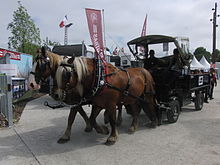Municipal horse
Their duties are diverse, typically involving tourism, waste management, maintenance of green spaces, safety and prevention, or personal transport.
While the use of horses may be considered traditional, some view them as more appealing than motorized vehicles due to their ecological benefits and potential for job creation, often at comparable or lower costs.
[1] In late 2012, a report by the Conseil général de l'alimentation, de l'agriculture et des espaces ruraux [fr] (CGAAER) defined the term as "a horse used by a local authority (either independently or as a service provider) to carry out public service missions in its territory, such as passenger transport, waste collection, maintenance of green spaces or natural areas, and prevention and security".
Since 1993, Bruno Rible has employed a grey mare named "Uranie" for municipal tasks such as garbage collection, cleaning gutters, and providing carriage rides for children.
[3] In 1999 and 2000, Trouville-sur-Mer implemented a similar system to manage its glass waste, motivated by the lower costs of acquiring a horse compared to specialized motor vehicles and the desire to minimize disturbances in the tourist area.
Additionally, horses can navigate narrow or steep streets more efficiently than motorized vehicles, making them suitable for short-distance tasks with frequent stops.
[19] However, public acceptance of using horses for waste collection remains low, with a significant percentage of the population expressing opposition, as indicated by a 2003 Kantar TNS poll.
[19] In some instances, horses or donkeys are employed for mechanical scanning, collection, upkeep, and lightweight maintenance of urban equipment, including pavements, sidewalks, and signposts, as well as maintaining paths and beaches.
The ecological benefits of using horses are significant, as they do not cause soil compaction, disturb local flora or fauna, or introduce pollutants such as hydrocarbons into the environment.
Horses offer greater flexibility and maneuverability compared to motorized vehicles, enabling them to navigate challenging terrains, including rivers and slopes, often at a lower operational cost.
Horses are favored for transportation and recreational activities in parks and gardens, and their use is compatible with Natura 2000 zones and historic sites, enhancing the visitor experience.
While horses can effectively carry out daily park activities, challenges remain in acquiring equipment specifically designed for horse-related tasks.
[22] Several municipalities have introduced horse-drawn transportation for schools, catering to both regular commutes in rural areas with small student populations and special excursions.
These initiatives are valued for the discreet, deterrent, and approachable presence of law enforcement on horseback, which allows for effective surveillance over large areas from an elevated position.
However, challenges remain, including limitations in training, the selection of suitable animals and personnel, and considerations for the well-being of horses during urban missions, which can complicate the implementation of these operations.
[24] Tourism plays a significant role in the initiatives involving municipal horses, with 85% of French horse-drawn transport associated with this sector, according to 2015 data.
This trend reflects both the high volume of tourist activity in France and the growing preference among visitors for a slower, more immersive vacation experience.
This cooperative effort aims to optimize costs and successfully bring the project to fruition, often involving a phase of experimentation and trial and error.
[12][67] The Commission nationale de développement des chevaux territoriaux, based in Trouville-sur-Mer,[68] organizes an annual congress to facilitate discussions and share best practices.
For instance, many carriage harnesses now include systems for collecting manure before it falls to the ground, and specialized horseshoes have been developed to reduce noise from hoof impacts.
The role of a coachman requires extensive practical knowledge, particularly in operating a carriage within urban environments and understanding the highway code applicable to horse-drawn vehicles.
[81] The presence of municipal horses can strengthen connections between residents and local officials, as well as foster a sense of community between urban and rural areas.
[82][81][36] The use of horses in protected natural areas allows for a more authentic experience without the disturbances typically associated with motorized vehicles, thereby improving the quality of life in those environments.
Ultimately, municipal horses tend to create more jobs compared to motorized vehicles,[12] contributing to the identity and character of the communities in which they operate.
While the presence of horses in urban settings can evoke positive feelings,[70] some elected officials view the implementation of mounted or harnessed public service missions as costly and time-consuming, leading to concerns about their overall effectiveness.








